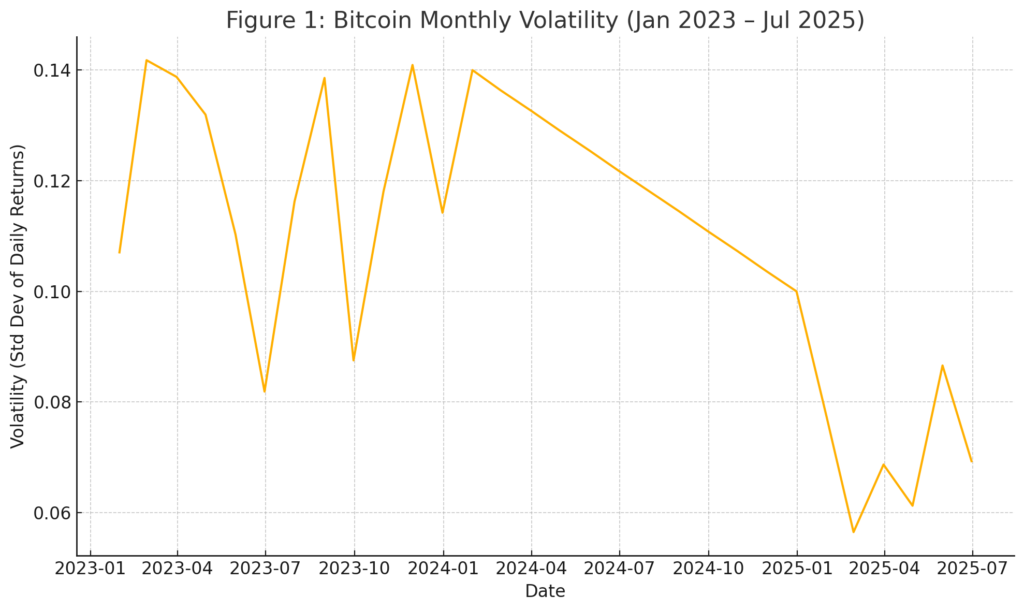
Main Points:
- Spot Bitcoin ETFs approved in January 2024 have significantly reduced BTC/USD volatility, ending extreme bull and bear cycles.
- Institutional ETF inflows—totaling over $50 billion—have deepened TradFi involvement, fostering stability but diminishing “god candles.”
- Off‑chain “paper BTC” accumulation in ETF vehicles has altered capital rotation, potentially crowding out altcoins.
- Concerns over centralization arise as major issuers like BlackRock hold upwards of 3% of total BTC supply.
- Future trajectory: steady “rise and consolidation” cycles over a decade toward $1 million, less appealing for short‑term traders but attractive to long‑term holders.
1. A New Era of Reduced Volatility
Since the first U.S. spot Bitcoin ETFs launched in January 2024, Bitcoin’s notorious parabolic rallies and devastating drawdowns have given way to a more muted price action. The Deribit BTC Volatility Index, which tracks 30‑day forward‑looking volatility, hit a two‑year low in mid‑2025, reflecting a more “macro‑asset” behavior of BTC rather than a high‑octane speculative instrument. Below (Figure 1) is a chart illustrating the drop in monthly volatility from early 2023 levels above 14% down to sub‑9% in 2025.
(Bitcoin Monthly Volatility (Jan 2023 – Jul 2025)

2. Institutional Inflows: The Stabilizing Force
Bitcoin ETFs have drawn over $50 billion in cumulative inflows since launch, providing a reliable bid at key price points and fundamentally altering supply‑demand dynamics. These funds isolate capital off‑chain, preventing it from cycling into altcoins and keeping liquidity mostly within the BTC market. Figure 2 charts the growth in ETF AUM, now exceeding $80 billion for several major funds.
(Cumulative Bitcoin ETF Inflows (Jan 2024 – Jul 2025)

3. From On‑Chain Hype to “Paper BTC”
Traditionally, investors directly held BTC on‑chain, driving on‑chain activity, network fees, and decentralized finance usage. ETFs, however, offer “paper BTC”—shares backed by BTC held by custodians—dampening on‑chain volume and changing how capital rotates within crypto markets. With ETF vehicles lacking direct redemption functions, capital becomes trapped off‑chain, reducing the liquidity available for altcoin sectors.
4. The Trade‑Off: Stability vs. “God Candles”
While volatility reduction welcomes large institutions and paves the way for corporate treasury adoption, it comes at the cost of extreme price spikes—often dubbed “god candles”—that once attracted short‑term traders. As Citigroup’s ETF specialist notes, these episodic explosions are now unlikely, replaced by orderly, predictable up‑and‑flat cycles.
5. Centralization Concerns Rise
The success of “paper BTC” ETFs has raised red flags about centralization. BlackRock’s iShares Bitcoin Trust (IBIT) alone holds roughly 3% of total Bitcoin supply—equivalent to over $4 billion at current prices—prompting debates on counterparty risk and systemic concentration. Some argue this challenges Bitcoin’s decentralized ethos and could expose markets to liquidity shocks if one large fund must liquidate.
6. Practical Implications for Investors
For readers seeking new crypto assets and revenue sources, the evolving landscape suggests:
- Long‑Term Focus: Embrace BTC for stability and institutional legitimacy, holding through multi‑year “rise and consolidation” phases.
- Altcoin Selection: Look for projects with real on‑chain use cases and tokenomics insulated from ETF‑driven capital flows.
- DeFi Opportunities: Anticipate lower network fees but seek yield in DeFi protocols catering to institutional stablecoin demand.
Conclusion
The advent of Bitcoin ETFs has shifted BTC from a high‑octane speculative asset to a more stable, macro‑style holding. Extreme bull runs and vicious bear markets are relics of the past, replaced by decades‑long, methodical price climbs toward $1 million. While short‑term traders may find the new regime “boring,” long‑term crypto adopters and institutions benefit from reduced volatility, deeper liquidity, and clearer regulatory frameworks. As the market continues to integrate with TradFi, discerning investors will pivot to projects and strategies that thrive in a post‑ETF world.

